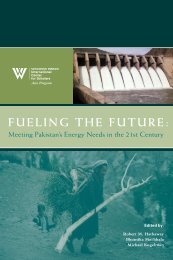Environmental Change and Security Project Report - Woodrow ...
Environmental Change and Security Project Report - Woodrow ...
Environmental Change and Security Project Report - Woodrow ...
You also want an ePaper? Increase the reach of your titles
YUMPU automatically turns print PDFs into web optimized ePapers that Google loves.
100<br />
is quite confusing, <strong>and</strong> instead of being a virtue,<br />
the breadth of the series diminishes the value of<br />
its contents.<br />
Launched by UNESCO in 2001, the PCCP<br />
program—together with the case studies on the<br />
Danube, Okavango, La Plata, Volga, <strong>and</strong> Volta<br />
river basins produced by Green Cross<br />
International’s “Water for Peace” project—<br />
examines <strong>and</strong> promotes the potential of shared<br />
water resources to catalyze regional peace <strong>and</strong><br />
development. 2 The joint program follows a<br />
three-track approach:<br />
• A disciplinary track examines historical<br />
experiences <strong>and</strong> reviews legal, negotiation,<br />
<strong>and</strong> system analysis tools for solving waterrelated<br />
conflicts;<br />
• A case study track draws lessons from the<br />
roots of transboundary water conflicts <strong>and</strong><br />
from examples of successful water cooperation;<br />
<strong>and</strong><br />
• An educational track develops negotiation<br />
skills <strong>and</strong> management techniques for shared<br />
water resources.<br />
In Water <strong>Security</strong> <strong>and</strong> Peace, World Water<br />
Council President William J. Cosgrove synthesizes<br />
the 28 volumes produced by the project.<br />
Summarizing the broad spectrum of PCCP<br />
studies is a difficult undertaking, so it may not<br />
be the author’s fault that the report lacks a common<br />
thread. Beginning with an overview of the<br />
history of water management, from the first<br />
hunter-gatherers to Roman cities to today’s<br />
industries, Water <strong>Security</strong> <strong>and</strong> Peace clearly shows<br />
that water has always engendered competition,<br />
<strong>and</strong> sometimes conflict. It also demonstrates<br />
that human civilization has developed solutions<br />
to address water shortages, but the increased<br />
speed at which they emerge, due to ever-rising<br />
water dem<strong>and</strong>s or pollution levels, gives people<br />
less time to adapt to new situations.<br />
Drawing on Fekri A. Hassan’s contribution<br />
to the PCCP series, “Water Management <strong>and</strong><br />
Early Civilizations: From Cooperation to<br />
Conflict,” Cosgrove suggests that “only a return<br />
to fundamental human values of justice <strong>and</strong><br />
equity will provide a sustainable solution to the<br />
world’s accelerating water crisis” (page 11) <strong>and</strong><br />
that ethics is the “ideal <strong>and</strong> only long-term<br />
solution” (page 19). While this approach would<br />
certainly be desirable, generating “a national<br />
discourse on water for peace <strong>and</strong> prosperity”<br />
<strong>and</strong> teaching “our children a system of moral<br />
principles…based on shared fundamental<br />
human values of justice <strong>and</strong> equity that will<br />
build this world of Water Peace” (page 23) is<br />
not a very practical solution.<br />
While the legal principles of international<br />
water law are sometimes difficult to apply, they<br />
do offer a framework for negotiations. Chapter<br />
4, “Legal Approaches: A Sound Framework,”<br />
draws on PCCP papers by Vinogradov,<br />
Wouters, <strong>and</strong> Jones (2003) <strong>and</strong> Shamir (2003)<br />
to provide a useful introduction to international<br />
water law <strong>and</strong> alternative dispute resolution<br />
mechanisms such as negotiation, mediation,<br />
arbitration, <strong>and</strong> fact-finding. According to the<br />
chapter, whether international law <strong>and</strong> multilateral<br />
agreements support sustainable water<br />
management <strong>and</strong> avoid water-related conflicts<br />
depends on local <strong>and</strong> national implementation.<br />
In their persuasive contribution to the series,<br />
“Untying the ‘Knot of Silence’: Making Water<br />
Policy <strong>and</strong> Law Responsive to Local Normative<br />
Systems,” Pieter van der Zaag <strong>and</strong> Jennifer<br />
Mohamed-Katerere question the efficiency of<br />
using the law to change water management in<br />
defined ways. Based on their analysis of<br />
Zimbabwe’s newly reformed water law <strong>and</strong><br />
other African case studies, the authors point out<br />
that “the impact of law—how it is lived <strong>and</strong><br />
experienced—is determined by its strength visà-vis<br />
other value <strong>and</strong> rule systems, including<br />
social, cultural, economic, <strong>and</strong> implementation<br />
systems, as well as its relationship to other institutions”<br />
(van der Zaag & Mohamed-Katerere,<br />
2003, page 3). Policymakers <strong>and</strong> legislators,<br />
therefore, should take into account the “nexus<br />
between law <strong>and</strong> practice” <strong>and</strong> thus consider<br />
customary law (“the vibrant body of rules <strong>and</strong><br />
principles that are flexible <strong>and</strong> constantly growing<br />
in response to a changing world”) when<br />
developing effective water law (pages 2-3).<br />
Water for Peace’s seventh chapter, “Obstacles<br />
to Cooperation,” lists challenges that can<br />
ECSP REPORT • ISSUE 10 • 2004

















